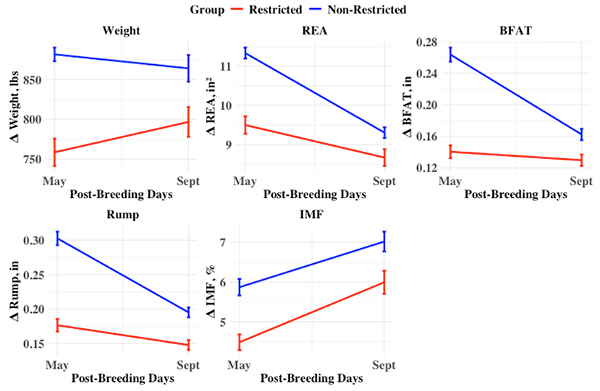Growing Beef Newsletter
April 2025, Volume 15, Issue 10
Transitioning heifers from a winter dry lot setting to a spring pasture management
Sarah Phelps, animal breeding and genetics graduate student, Iowa State University
Heifer development guidelines recommend development to promote the early onset of puberty and to develop heifers to a target body weight at the time of breeding. However, research indicates that nutritional status during the first 21 days of the breeding season may be as important as prebreeding. Heifers who gain weight during the first 21 days of the breeding season have been shown to have increased conception compared to heifers who lose weight during this timeframe. Research from South Dakota State University found negative implications on embryonic development and survival when heifers are transitioned to a reduced gain diet directly after AI breeding. This should be considered when transitioning heifers from a dry lot to pasture, as this transition can cause changes in body weight and composition just before or at the initiation of the breeding season.
In a recent heifer development study conducted at Iowa State University’s McNay Memorial Research and Demonstration Farm, the pregnancy rates of heifers in two dietary groups were compared: a restricted group, developed to 55% of their mature body weight at breeding, and a non-restricted group, developed to 65% of their mature body weight at breeding. Due to 2023 drought conditions, heifers in the restricted group were developed on a lower energy diet in a larger pen area until adequate pasture growth for turn out 3 weeks before AI breeding. Heifers in the non-restricted group were developed in standard dry lot conditions until breeding. After AI breeding, all heifers were managed as one group on pasture.
Body weight and condition changes were collected using carcass ultrasound measurements before breeding and at the final pregnancy ultrasound diagnosis, thirty days following a 45-day breeding season. Figure 1 shows the change in body weight and carcass ultrasound measurements for ribeye area (REA), backfat (BFAT), rump fat (RUMP), and intramuscular fat (IMF) taken in May before AI breeding and in September at the final pregnancy determination. On average, the non-restricted group lost weight while managed on pasture compared to the restricted group who continued to gain weight. Both groups, on average, lost condition for REA, BFAT, and RUMP measurements, with this decrease being larger in the non-restricted group. Interestingly, both groups continued to gain IMF while on pasture. Pregnancy results from this study found that final heifer pregnancy rates (AI bred and natural service bred) did not differ between the two groups. Numerically, more in the non-restricted group were bred by AI compared to the restricted group, but this difference was not statistically significant.
These results highlight the importance of developing heifers based on the specific management practices and goals of a cow-calf operation. Developing heifers to higher body weights resulted in more AI bred, but these heifers lost more body condition when transitioned to pasture management. The total number of bred heifers did not differ between the groups. Developing heifers to lower body weights resulted in less extreme body condition loss when transitioned to pasture, continued weight gain, and saved $76 per head in feed costs. Final pregnancy rates did not differ between the two dietary groups. When determining the optimal body weight to breed heifers, nutritional availability and operational goals should be considered to maximize reproductive rates and operational profitability.

Figure 1. Body weight and composition measurements taken before artificial insemination (AI) breeding in May 2024 and at final pregnancy determination in September 2024 after summer pasture management.
This monthly newsletter is free and provides timely information on topics that matter most to Iowa beef producers. You’re welcome to use information and articles from the newsletter - simply credit Iowa Beef Center.
